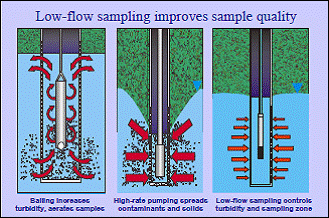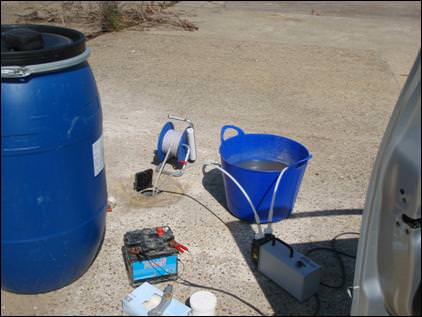|
|
|
Groundwater Sampling – Traditional or Low Flow Sampling
While fixed-volume purging with bailers or submersible high-flow pumps can remove overlying stagnant water from a well and provide a sample of the groundwater near the borehole, researchers have determined that these traditional purging practices pose significant scientific and practical concerns. These include:
- High pumping rates and bailers can greatly increase the turbidity of samples. This can cause biased or ‘false-positive’ analytical results and interfere with sample analysis. Filtering samples to remove turbidity can further alter sample chemistry.
- Bailers, while inexpensive to purchase, can introduce further bias or error in sample results due to aeration, sample agitation, surging, and contamination due to handling of the bailer at the wellhead.
- In low-yield wells, complete dewatering of the well can aerate the sample water; stripping out volatile organic compounds (VOCs) and precipitating dissolved metals from samples thus affecting sample chemistry.
- High pumping rates can cause mixing of chemically distinct water zones within the aquifer such as floating, light non-aqueous phase liquids (LNAPLs), diluting or averaging the sample, and often spreading further contaminants within the aquifer.
- Field technicians must properly handle the large volumes of purged water generated. Where the purge water is contaminated or when regulatory requirements specify, the water must be contained in tanks or drums and often removed for off-site treatment or disposal, increasing sampling costs.
- Excessive high-rate pumping of monitoring wells can lead to damage of the well filter pack and annular seal.
 Low flow purging and sampling involves extracting groundwater at rates comparable to ambient groundwater flow (typically less than 500 ml/min), so that the drawdown of the water level is minimized, and the mixing of stagnant water with water from the screened intake area in a well is reduced. Low flow purging and sampling involves extracting groundwater at rates comparable to ambient groundwater flow (typically less than 500 ml/min), so that the drawdown of the water level is minimized, and the mixing of stagnant water with water from the screened intake area in a well is reduced.

Photograph 1 – AFHA Low flow purging set-up.
Advantages of low-flow purging and sampling
Purging and sampling at low flow rates offers several advantages over traditional purging methods:
- Sample quality is improved through reduced turbidity, minimised degassing and volatilisation. The need for sample filtration is eliminated, further reducing sampling costs and analytical expenses.
- Sample accuracy and precision are also improved, avoiding regulatory issues with suspected contamination and costly resampling to explain erroneous results.
- Purge volume is typically reduced by ninety percent or more, resulting in significant savings in handling, treatment or disposal costs.
- Sampling systems are simpler and less expensive, as the need for high-flow purging pumps is eliminated.
- Extends the useful life of a monitoring well and preserves the integrity of the filter pack by reducing the movement of fine sediments into the well.
This is not to say that traditional purging and sampling methods are redundant but that for sensitive sites, low flow sampling is the recommended methodology.
|
|
Call 01603 250754 or click here to send an enquiry by email
|

 Low flow purging and sampling involves extracting groundwater at rates comparable to ambient groundwater flow (typically less than 500 ml/min), so that the drawdown of the water level is minimized, and the mixing of stagnant water with water from the screened intake area in a well is reduced.
Low flow purging and sampling involves extracting groundwater at rates comparable to ambient groundwater flow (typically less than 500 ml/min), so that the drawdown of the water level is minimized, and the mixing of stagnant water with water from the screened intake area in a well is reduced. 